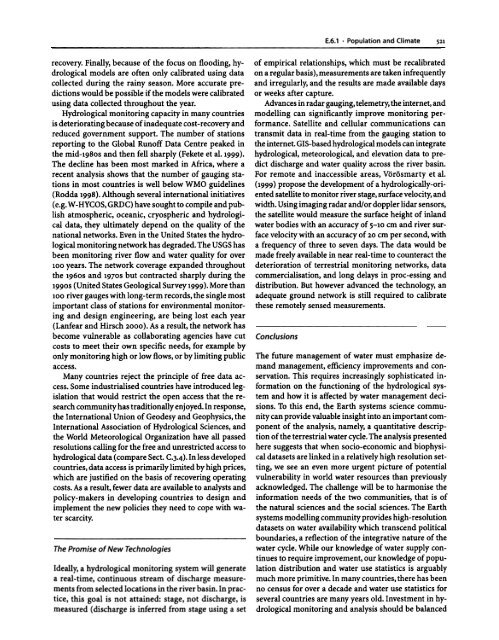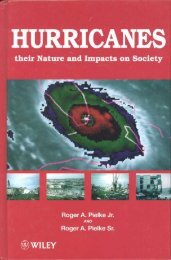How to evaluate vulnerability in changing environmental conditions
How to evaluate vulnerability in changing environmental conditions
How to evaluate vulnerability in changing environmental conditions
You also want an ePaper? Increase the reach of your titles
YUMPU automatically turns print PDFs into web optimized ePapers that Google loves.
ecovery. F<strong>in</strong>ally, because of the focus on flood<strong>in</strong>g, hydrological<br />
models are often only calibrated us<strong>in</strong>g data<br />
collected dur<strong>in</strong>g the ra<strong>in</strong>y season. More accurate predictions<br />
would be possible if the models were calibrated<br />
us<strong>in</strong>g data collected throughout the year.<br />
Hydrological moni<strong>to</strong>r<strong>in</strong>g capacity <strong>in</strong> many countries<br />
is deteriorat<strong>in</strong>g because of <strong>in</strong>adequate cost-recovery and<br />
reduced government support. The number of stations<br />
report<strong>in</strong>g <strong>to</strong> the Global Runoff Data Centre peaked <strong>in</strong><br />
the mid-1980s and then fell sharply (Fekete et al. 1999).<br />
The decl<strong>in</strong>e has been most marked <strong>in</strong> Africa, where a<br />
recent analysis shows that the number of gaug<strong>in</strong>g stations<br />
<strong>in</strong> most countries is well below WMO guidel<strong>in</strong>es<br />
(Rodda 1998). Although several <strong>in</strong>ternational <strong>in</strong>itiatives<br />
(e.g. W -HYCOS, GRDC) have sought <strong>to</strong> compile and publish<br />
atmospheric, oceanic, cryospheric and hydrological<br />
data, they ultimately depend on the quality of the<br />
national networks. Even <strong>in</strong> the United States the hydrological<br />
moni<strong>to</strong>r<strong>in</strong>g network has degraded. The USGS has<br />
been moni<strong>to</strong>r<strong>in</strong>g river flow and water quality for over<br />
100 years. The network coverage expanded throughout<br />
the 1960s and 1970S but contracted sharply dur<strong>in</strong>g the<br />
1990S (United States Geological Survey 1999). More than<br />
100 river gauges with long-term records, the s<strong>in</strong>gle most<br />
important class of stations for <strong>environmental</strong> moni<strong>to</strong>r<strong>in</strong>g<br />
and design eng<strong>in</strong>eer<strong>in</strong>g, are be<strong>in</strong>g lost each year<br />
(Lanfear and Hirsch 2000). As a result, the network has<br />
become vulnerable as collaborat<strong>in</strong>g agencies have cut<br />
costs <strong>to</strong> meet their own specific needs, for example by<br />
only moni<strong>to</strong>r<strong>in</strong>g high or low flows, or by limit<strong>in</strong>g public<br />
access.<br />
Many countries reject the pr<strong>in</strong>ciple of free data access.<br />
Some <strong>in</strong>dustrialised countries have <strong>in</strong>troduced legislation<br />
that would restrict the open access that the re-<br />
search community has traditionally enjoyed. In response,<br />
the International Union of Geodesy and Geophysics, the<br />
International Association of Hydrological Sciences, and<br />
the World Meteorological Organization have all passed<br />
resolutions call<strong>in</strong>g for the free and unrestricted access <strong>to</strong><br />
hydrological data (compare Sect. C.3.4). In less developed<br />
countries, data access is primarily limited by high prices,<br />
which are justified on the basis of recover<strong>in</strong>g operat<strong>in</strong>g<br />
costs. As a result, fewer data are available <strong>to</strong> analysts and<br />
policy-makers <strong>in</strong> develop<strong>in</strong>g countries <strong>to</strong> design and<br />
implement the new policies they need <strong>to</strong> cope with water<br />
scarcity.<br />
The Promise of New Technologies<br />
Ideally, a hydrological moni<strong>to</strong>r<strong>in</strong>g system will generate<br />
a real-time, cont<strong>in</strong>uous stream of discharge measurements<br />
from selected locations <strong>in</strong> the river bas<strong>in</strong>. In practice,<br />
this goal is not atta<strong>in</strong>ed: stage, not discharge, is<br />
measured (discharge is <strong>in</strong>ferred from stage us<strong>in</strong>g a set<br />
E.6.1 .Population and Climate 521<br />
of empirical relationships, which must be recalibrated<br />
on a regular basis), measurements are taken <strong>in</strong>frequently<br />
and irregularly, and the results are made available days<br />
or weeks after capture.<br />
Advances <strong>in</strong> radar gaug<strong>in</strong>g, telemetry, the <strong>in</strong>ternet, and<br />
modell<strong>in</strong>g can significantly improve moni<strong>to</strong>r<strong>in</strong>g performance.<br />
Satellite and cellular communications can<br />
transmit data <strong>in</strong> real-time from the gaug<strong>in</strong>g station <strong>to</strong><br />
the <strong>in</strong>ternet. GIS-based hydrological models can <strong>in</strong>tegrate<br />
hydrological, meteorological, and elevation data <strong>to</strong> predict<br />
discharge and water quality across the river bas<strong>in</strong>.<br />
For remote and <strong>in</strong>accessible areas, Vorosmarty et al.<br />
(1999) propose the development of a hydrologically-oriented<br />
satellite <strong>to</strong> moni<strong>to</strong>r river stage, surface velocity, and<br />
width. Us<strong>in</strong>g imag<strong>in</strong>g radar and/or doppler lidar sensors,<br />
the satellite would measure the surface height of <strong>in</strong>land<br />
water bodies with an accuracy of 5-10 cm and river surface<br />
velocity with an accuracy of 20 cm per second, with<br />
a frequency of three <strong>to</strong> seven days. The data would be<br />
made freely available <strong>in</strong> near real-time <strong>to</strong> counteract the<br />
deterioration of terrestrial moni<strong>to</strong>r<strong>in</strong>g networks, data<br />
commercialisation, and long delays <strong>in</strong> proc-ess<strong>in</strong>g and<br />
distribution. But however advanced the technology. an<br />
adequate ground network is still required <strong>to</strong> calibrate<br />
these remotely sensed measurements.<br />
Conclusions<br />
The future management of water must emphasize demand<br />
management, efficiency improvements and conservation.<br />
This requires <strong>in</strong>creas<strong>in</strong>gly sophisticated <strong>in</strong>formation<br />
on the function<strong>in</strong>g of the hydrological system<br />
and how it is affected by water management decisions.<br />
To this end, the Earth systems science community<br />
can provide valuable <strong>in</strong>sight <strong>in</strong><strong>to</strong> an important component<br />
of the analysis, namely, a quantitative description<br />
of the terrestrial water cycle. The analysis presented<br />
here suggests that when socio-economic and biophysical<br />
datasets are l<strong>in</strong>ked <strong>in</strong> a relatively high resolution sett<strong>in</strong>g,<br />
we see an even more urgent picture of potential<br />
<strong>vulnerability</strong> <strong>in</strong> world water resources than previously<br />
acknowledged. The challenge will be <strong>to</strong> harmonise the<br />
<strong>in</strong>formation needs of the two communities, that is of<br />
the natural sciences and the social sciences. The Earth<br />
systems modell<strong>in</strong>g community provides high-resolution<br />
datasets on water availability which transcend political<br />
boundaries, a reflection of the <strong>in</strong>tegrative nature of the<br />
water cycle. While our knowledge of water supply cont<strong>in</strong>ues<br />
<strong>to</strong> require improvement, our knowledge of population<br />
distribution and water use statistics is arguably<br />
much more primitive. In many countries, there has been<br />
no census for over a decade and water use statistics for<br />
several countries are many years old. Investment <strong>in</strong> hydrological<br />
moni<strong>to</strong>r<strong>in</strong>g and analysis should be balanced














